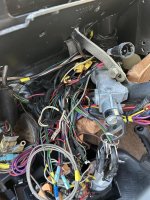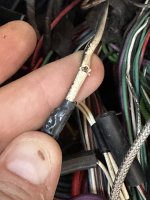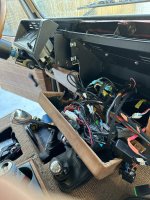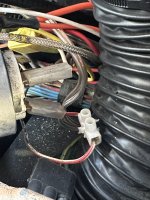This is the next play. Going to get to know this thing intimately very quicklySince you said it smelled of burnt electrical, I'd pull the dash binnacle and look around for burnt components. It's only a matter of screws to remove. Relays, such as your glow timer, can switch rapidly on-off when there are other faults such as bad grounds or shorts.
You are using an out of date browser. It may not display this or other websites correctly.
You should upgrade or use an alternative browser.
You should upgrade or use an alternative browser.
Bought a 110: immediate non-start
- Thread starter Iancoletx
- Start date
Here is today's update.. tore the dash off for the most part, it was dead easy which is nice. Disconnected auxillary lines from the battery positive terminal, no effect. Found two more inline fuses in the dash behind the a/v, both good, all inline and vehicle fuses have been checked.
Wiring behind the gauge cluster is generally a fucking mess with a history told in defunct splices and unused connectors. I have not found anything that looks like an obvious culprit except that the line coming off of the (looking at it directly from front) left rear of the ignition (pic 2) is in unacceptable condition, and the rest of the ignition lines (pic 4) look pretty crappy. Everything looks crappy.
Running to pick up some spade connectors, etc. Any ideas on how to start trying to isolate this issue are most kindly and enthusiastically welcomed.
I own a pretty excellent property in Big Bend National Park Area, and I am offering a bounty of a very friendly vacation discount for anyone who helps me find and kill this gremlin.
I have this feeling that I'm going to end up with a completely disassembled interior.
Best,
Ian
Wiring behind the gauge cluster is generally a fucking mess with a history told in defunct splices and unused connectors. I have not found anything that looks like an obvious culprit except that the line coming off of the (looking at it directly from front) left rear of the ignition (pic 2) is in unacceptable condition, and the rest of the ignition lines (pic 4) look pretty crappy. Everything looks crappy.
Running to pick up some spade connectors, etc. Any ideas on how to start trying to isolate this issue are most kindly and enthusiastically welcomed.
I own a pretty excellent property in Big Bend National Park Area, and I am offering a bounty of a very friendly vacation discount for anyone who helps me find and kill this gremlin.
I have this feeling that I'm going to end up with a completely disassembled interior.
Best,
Ian
Attachments
Progress
WreckITFrank
Technical Excellence Contributor
I love wiring drama, it's so common in these trucks it's not even funny anymore, it's to be expected.
What are those thick red and orange wires? I see the egt probe line is damaged or melted into a yellow connector?
What are those thick red and orange wires? I see the egt probe line is damaged or melted into a yellow connector?
Last edited:
erover82
0
Also, a few notes:
It could be a lot worse. At least your wiring doesn't appear to be filthy and someone appears to have used proper harness tape on some parts. Definitely could use a good going over and rectification of any issues though.
I'd repair the white wire's insulation with sealing heat shrink. Try to ensure the terminals your replace are good quality. They should be nickel or tin plated and of reasonable thickness. Cheap kits online are usually thin steel. Hi Temp made in USA kits are one of many good options. I prefer uninsulated terminals with the correct crimping tool, but waterproof insulated terminals are decent too.
The braided cable in pic 4 appears to have a discolored area which indicates it was rubbing on something. Braided cable is abrasive and really should be sheathed to prevent this. I'd look into this, as if it didn't cause the issue at hand, it will likely cause one in the future.
The red/white wire should be repaired as well, similar to above, with either a high quality uninsulated crimped butt connector with waterproof heatshrink over it, soldered and heatshrinked, or a waterproof crimped butt connector.
As a general strategy for this vehicle, you'll probably find that the areas where people don't look are where it may need attention. I mean this constructively, but companies such as Monarch often take what is essentially a farm truck and flip it to a more wealthy audience by transforming it (at least visually) into a more G-wagen like luxury SUVs. They do this primarily by painting and reupholstering them. Some go further, but it really varies, and the quality varies as well. Your truck looks really nice, but it's hard to know how well the electrical and mechanical has been sorted without a really detailed look.
The juxtaposition of the nice paint/upholstery and the very agricultural 200Tdi engine in this truck is interesting too. The 200Tdi is a fun little engine that I really enjoy, but it is a little engine (especially in a 110), and like nearly all old mechanical diesels, is loud and often smokey. Most owners who move into high-end Defender ownership without understanding that they were engineered for agricultural, rural, military, NGO, off-road, etc use where high-speeds are a low priority, are often disappointed when they don't fly down an American freeway at 80mph effortlessly. Hopefully it'll treat you well after this initial hiccup. They're a simple, easy to work on, all mechanical engine, with a nice sound. They can be very enjoyable if one values those attributes. If its agricultural nature proves impractical though, there are several engine swap options available that can transform the performance. Anyways, welcome to classic British car ownership! The classic Land Rover world is a particularly fun slice of it.
It could be a lot worse. At least your wiring doesn't appear to be filthy and someone appears to have used proper harness tape on some parts. Definitely could use a good going over and rectification of any issues though.
I'd repair the white wire's insulation with sealing heat shrink. Try to ensure the terminals your replace are good quality. They should be nickel or tin plated and of reasonable thickness. Cheap kits online are usually thin steel. Hi Temp made in USA kits are one of many good options. I prefer uninsulated terminals with the correct crimping tool, but waterproof insulated terminals are decent too.
The braided cable in pic 4 appears to have a discolored area which indicates it was rubbing on something. Braided cable is abrasive and really should be sheathed to prevent this. I'd look into this, as if it didn't cause the issue at hand, it will likely cause one in the future.
The red/white wire should be repaired as well, similar to above, with either a high quality uninsulated crimped butt connector with waterproof heatshrink over it, soldered and heatshrinked, or a waterproof crimped butt connector.
As a general strategy for this vehicle, you'll probably find that the areas where people don't look are where it may need attention. I mean this constructively, but companies such as Monarch often take what is essentially a farm truck and flip it to a more wealthy audience by transforming it (at least visually) into a more G-wagen like luxury SUVs. They do this primarily by painting and reupholstering them. Some go further, but it really varies, and the quality varies as well. Your truck looks really nice, but it's hard to know how well the electrical and mechanical has been sorted without a really detailed look.
The juxtaposition of the nice paint/upholstery and the very agricultural 200Tdi engine in this truck is interesting too. The 200Tdi is a fun little engine that I really enjoy, but it is a little engine (especially in a 110), and like nearly all old mechanical diesels, is loud and often smokey. Most owners who move into high-end Defender ownership without understanding that they were engineered for agricultural, rural, military, NGO, off-road, etc use where high-speeds are a low priority, are often disappointed when they don't fly down an American freeway at 80mph effortlessly. Hopefully it'll treat you well after this initial hiccup. They're a simple, easy to work on, all mechanical engine, with a nice sound. They can be very enjoyable if one values those attributes. If its agricultural nature proves impractical though, there are several engine swap options available that can transform the performance. Anyways, welcome to classic British car ownership! The classic Land Rover world is a particularly fun slice of it.
Last edited:
Shorting brown to white initiates things happening including the sci fi noise from the glow plug timer, so I am going to assume it activates the fuel shut solenoid.
Short brown to red/white does *not* kick the starter over, it causes the left most (yellow) relay box below the under dash fuses to buzz and that is the extent of the action.
Short brown to red/white does *not* kick the starter over, it causes the left most (yellow) relay box below the under dash fuses to buzz and that is the extent of the action.
erover82
0
Shorting brown to white initiates things happening including the sci fi noise from the glow plug timer, so I am going to assume it activates the fuel shut solenoid.
Short brown to red/white does *not* kick the starter over, it causes the left most (yellow) relay box below the under dash fuses to buzz and that is the extent of the action.
It's interesting that in both cases you've got relays which are oscillating. Relay is open, voltage is (relatively) high, relay closes, load is applied, voltage drops, relay closes, repeat = buzzzz.
It's either a bad wire/contact somewhere, your battery is dead, and/or the starter is drawing so much current that it's dropping the system voltage below the relay activation point.
Checking grounds, connections, battery, and as expanse suggested, hotwiring the starter are all prudent options.
Last edited:
expanse
0
starting to feel like poor grounds are your enemy here.
inspect battery negative terminal, clamp (is it tight?), and cable. follow ground cable and see where it goes; Chassis? Chassis & Driveline? is the cable hard as a rock? show any signs of corrosion or melting?
If you run a jumper cable from a clean spot on the bellhousing to the negative terminal of the battery (don't need to remove the negative terminal, just clamp right over it w/ jumper gator clamp), does any of the buzzing go away? can you bump the starter using the key? This is me assuming the stock metal grounding straps (engine to chassis) are complete shit.
side note, i'd place an order for a new main wiring harness. that mess is just asking for another round of issues in a few months. getting proactive on it will be a huge help long term. not saying it needs to be done now, just schedule a time for it and not feel the pressure.
hope this helps.
inspect battery negative terminal, clamp (is it tight?), and cable. follow ground cable and see where it goes; Chassis? Chassis & Driveline? is the cable hard as a rock? show any signs of corrosion or melting?
If you run a jumper cable from a clean spot on the bellhousing to the negative terminal of the battery (don't need to remove the negative terminal, just clamp right over it w/ jumper gator clamp), does any of the buzzing go away? can you bump the starter using the key? This is me assuming the stock metal grounding straps (engine to chassis) are complete shit.
side note, i'd place an order for a new main wiring harness. that mess is just asking for another round of issues in a few months. getting proactive on it will be a huge help long term. not saying it needs to be done now, just schedule a time for it and not feel the pressure.
hope this helps.
I would be using this form to get some assistance as this is not a good look for them: https://monarchdefender.com/contact/
Just an FYI, when I ordered a harness from Autosparks UK for my 110, the lead time was about 10 weeks. So if you go that route you should plan in advance.side note, i'd place an order for a new main wiring harness
Whenever I'm working electrical, I start with the basics and build up confidence.
Check the battery terminals
Check that the battery cables are right and not reversed.
Check for any loose wires (especially since this was transported)
Check frame and engine strap grounds (especially since this was transported) <- a lot of your symptoms could be this in my experience
Check basic power items... Do the lights work when the key is on? Headlights, high beams, turns, brakes, etc.
Check 12V outlets, wipers, etc. I tend to not check defrosters or heating elements like seats because you don't want those to get stuck on.
Check fan controls.
I turn these on and off one at a time, then in groups when I'm confident they work individually.
If this stuff works, you can have some confidence in the electrical. now you know your base foundation is pretty solid.
If it doesn't, you've generally found a much easier problem to troubleshoot than something intermittent.
If you have a set of jumper cables, jump from the engine block to the negative battery terminal and see if that changes anything. Then jump from block to bulkhead or neg battery terminal to bulkhead.
I've had my stop solenoid wire break internally which resulted in intermittent shutoffs. I've also had the frame to block ground come loose which did a lot of weird crazy things.
Check the battery terminals
Check that the battery cables are right and not reversed.
Check for any loose wires (especially since this was transported)
Check frame and engine strap grounds (especially since this was transported) <- a lot of your symptoms could be this in my experience
Check basic power items... Do the lights work when the key is on? Headlights, high beams, turns, brakes, etc.
Check 12V outlets, wipers, etc. I tend to not check defrosters or heating elements like seats because you don't want those to get stuck on.
Check fan controls.
I turn these on and off one at a time, then in groups when I'm confident they work individually.
If this stuff works, you can have some confidence in the electrical. now you know your base foundation is pretty solid.
If it doesn't, you've generally found a much easier problem to troubleshoot than something intermittent.
If you have a set of jumper cables, jump from the engine block to the negative battery terminal and see if that changes anything. Then jump from block to bulkhead or neg battery terminal to bulkhead.
I've had my stop solenoid wire break internally which resulted in intermittent shutoffs. I've also had the frame to block ground come loose which did a lot of weird crazy things.
BOYS WOULD YOU BELIEVE
It was the fucking battery.
18 month old Interstate AGM killed dead (bad cell?) by a standard issue dewalt charger. Amazing.
Glad that I was able to explore the vehicle a little bit and to correct those janky ignition wires.
Tomorrow it goes back together and I begin diagnosing this non-start.
Back at square negative 1.
This is obviously a fantastic community, thank you guys.
It was the fucking battery.
18 month old Interstate AGM killed dead (bad cell?) by a standard issue dewalt charger. Amazing.
Glad that I was able to explore the vehicle a little bit and to correct those janky ignition wires.
Tomorrow it goes back together and I begin diagnosing this non-start.
Back at square negative 1.
This is obviously a fantastic community, thank you guys.
WreckITFrank
Technical Excellence Contributor
Hopefully you can unsee some of what you saw so you can enjoy it without having to rip everything apart. (Aside from anything dangerous). https://www.britishwiring.com/ has the correct wire you need for repairs. Grounds should still all be checked. Glad it was easy (ish) in the end.
Last edited:
Its no LS but my (slightly turned up fueling) 300tdi flies at 80 effortlessly, its the rest of the body that doesn't like itthey don't fly down an American freeway at 80mph effortlessly.
erover82
0
Its no LS but my (slightly turned up fueling) 300tdi flies at 80 effortlessly, its the rest of the body that doesn't like it
Yeah the poor things have their work cut out for them. You're right though, when tuned well they can perform much better. For some owners it's difficult to get there - they either don't know how, don't have access to a shop that knows, or don't know it's possible. Some of the fueling and cooling issues can be a pain to figure out too. How many enthusiasts even are unaware there's a filter in the injection pump or a thermostat in the oil housing that can lead to issues?



